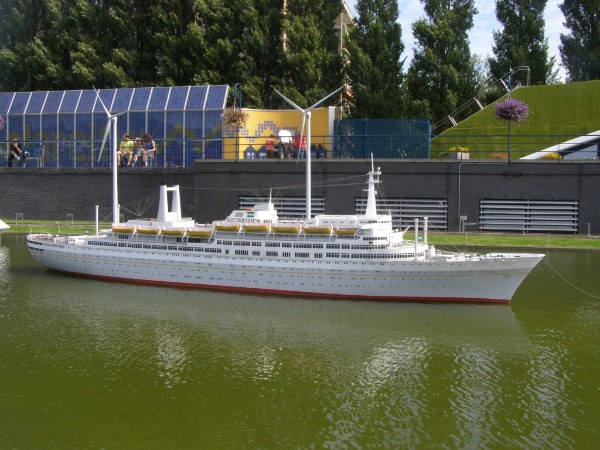Rotterdam (V)
This magnificent ship was built at the Rotterdamsche Droogdok Maatschappij as the biggest passengership ever built in the Netherlands. Her tonnage is just under 40.000 and she could accommodate 1499 passengers and 575 crew. She sailed at 21,5 knots. Her length is 228,18 meters, width 28,71 meters and her draft 9,04 meters.
In the 1950's, Holland America Line was looking for a new flagship that could sail together with the great Nieuw Amsterdam of 1938. The outbreak of the second worldwar and the shortage of materials thereafter caused the company to built a ship of that size not earlier than this. In 1956 they had introduced a moderate sized ship named Statendam but she was unable to maintain a scedule together with the much larger Nieuw Amsterdam. Two other small ships, Maasdam and Ryndam were introduced also in the beginning of the 1950's but they were build as immigrant liners and cruiseships. A true big Atlantic liner was needed to keep up with foreign competition. In the 1950's, ocean traffic on the Atlantic Ocean was booming, mainly because of warbrides and Americans who had to see their European roots. Next to that, people simply had more money to spent now the waryears were over. At the 13th of september 1958, Holland America was able to launch a new ocean giant from the yard of the Rotterdamse Droogdok Maatschappij in Rotterdam. She was somewhat bigger then her older fleetmate Nieuw Amsterdam and she was designed not only for line-voyages, but also with cruising in mind. Holland America Line thought forward and imagined that somewhere in the near future, airtravel would outpass oceantravel. So besides the traditional route this ship was easy to convert to sail cruises. For this purpose, even the staircase and dividing walls between classes could be changed so passengers could enjoy the whole of the ship on cruises. An innovating idea that gave every class of passenger the feeling that they were able to use the whole ship. The inspiration for the split staircase came from the castle of Chambord in France. Here, the stairs were also split so that the servants did not cross paths with their superiours when there was no need for.
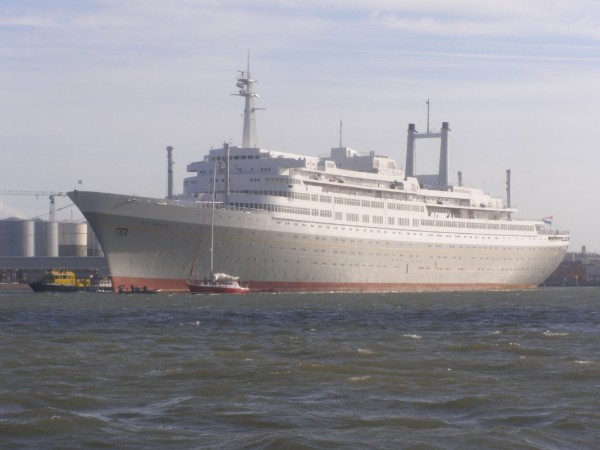
The ship was named after her homeport of Rotterdam and it was the fifth time this name was used in the history of the company. Her trials took place in july of 1959 and her first crossing to New York started in Rotterdam on the 3th of september of that year.
The ship was a true masterpiece, still recognized as one of the most beautiful oceanliners ever built to this very day. Her interiours were totally designed by Dutch architects like J.A. van Tienhoven and H.A. Maaskant. Maaskant also had designed the Euromast at Rotterdam, by the way, so he was a very well known name. Van Tienhoven had designed around 250 interiours of all kinds of ships before 1970, so in his field he also was the top-designer in The Netherlands. She was also the first to be built without a traditional funnel, sometimes disliked by people who did not see in her a true ship. But at least the P&O Line was impressed, because they adopted this idea for their new flagship Canberra that entered service in 1960. The hardware of the ship was also only Dutch. The ships generators were designed by Werkspoor from Utrecht, the turbines built by De Schelde at Vlissingen and the ship itself was of course built and designed at the RDM. This made the ship a true Dutch ship and one of the last examples of a 'ship of state' in the world. When introduced, she was the fifth largest oceanliner in the world. Her Dutchness was also the main reason why so many hands tried and succeeded in preserving the ship, where you can read about later on this page.
In 1970, the Rotterdam was taken out of her transatlantic service. Now only the Nieuw Amsterdam continued these line-voyages untill 1974 when this old ship sailed for the breakers yard. Several plans to preserve this 1938-built ship failed. There even was a plan to use the Nieuw Amsterdam as an erotic centre in Rotterdam.
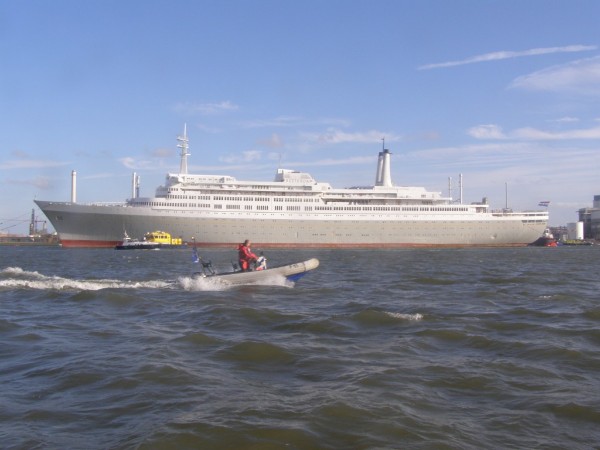
When Rotterdam was taken out of transatlantic service in 1970, she left her homeport and did not come back there untill 1998. But still, Dutch people admired the ship all the time when she was sailing for Holland America Line. In 1973, her homeport changed from Rotterdam to Willemstad on Curacao and also the location of the Holland America Line headoffice was changed to Willemstad, leaving The Netherlands itself without a big company owning passengerships, although Curacao is part of the Kingdom of the Netherlands so the ships were still Dutch.
A few problems happened to the Rotterdam in the 1970's, in 1973 a dockwall almost collapsed when the ship was in drydock in Lisbon and she was nearly destroyed. In 1976, a giant wave caused considerable damage to the ship but this could be repaired. Furthermore, her carreeer with Holland America Line was very succesful and her fame spread around the world. Holland America Line kept her in service untill 1997, a remarkable 38 years. For a ship that was built as a transatlantic liner this is exceptional. She was maintained very well untill the last days she sailed for Holland America Line, even named the 'Ship Of The Year' in 1997. She just was not able to give her passengers all modern needs and that was the reason she had to go. Also, she was still a steamship, never rebuilt as a motorship and it became less economical to run the ship in the premium brand Holland America was. One of the potential buyers was the city of Rotterdam, who firstly believed it was possible to buy the ship and bring it back to the city for use as a static monument, museum and hotel. Something that was proposed for the Nieuw Amsterdam in the early 1970's and finally came to nothing when the ship was sold for scrap. Rotterdam was the last possibility for the city to preserve an important part of its history. But the citycouncil later rejected the idea of being too costly, mainly because the asbestos aboard that had to be removed. Also, HAL is said to have insisted for some radical side-conditions like naming a street HAL-street, a yearly supply of 5 million brochures and the name of HAL had to be placed on the most visual place on the stadium of footballclub Feyenoord.
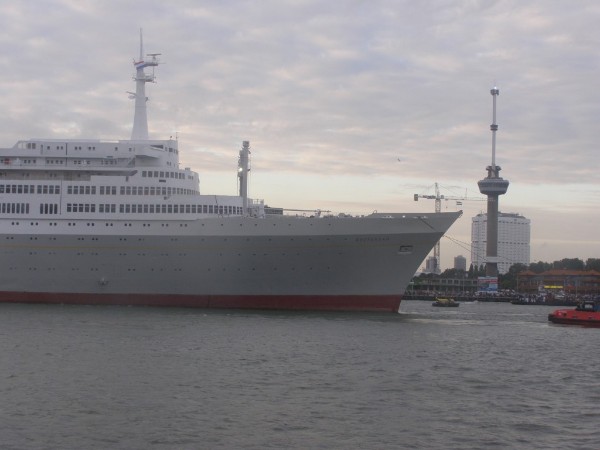
Rotterdam was instead sold to Premier Cruise Line, a company that specialized on older cruiseships and was sailing Caribbean cruises. The ship was renamed Rembrandt to not loose her Dutch history. Premier Cruises did give the Dutch fans of the ship a present when they decided to let the ship come back to Holland once more in the late summer of 1998. A lot of people went to the harbour to see her, asuming that it was their last chance. Premier Cruises started to give all of their ships red hulls from the late 1990's onwards, and renamed them The Big Red Boat I, II and III. The Rembrandt kept her name and darkblue hull. Although she was still in a fairly good condition, in april of 1999 she suffered severe engine problems during a cruise from Rio de Janeiro to Barcelona. The ship was filled with smoke and the airconditioning failed, causing the company to cancell several stops along the way. Because the passengers didn't think that enough was done, they took matters in their own hands, stating that they would themselves take control. Also, the passengers demanded that their money would been paid back due to the problems and cancellation of much of the cruise. When this wasn't realized, they would refuse to leave the ship at Barcelona. Finally, the ship docked at Las Palmas, Gran Canaria and Premier Cruises arranged three planes to take the Lisbon-bound Brazilian passengers to Portugal. Others stayed on board and continued on to Barcelona. Premier stated that everybody was compensated.
Below, Rembrandt is seen passing Hoek van Holland on her last cruise from The Netherlands in 1998. This is actually one of the last pictures ever taken of her leaving her former homeport.
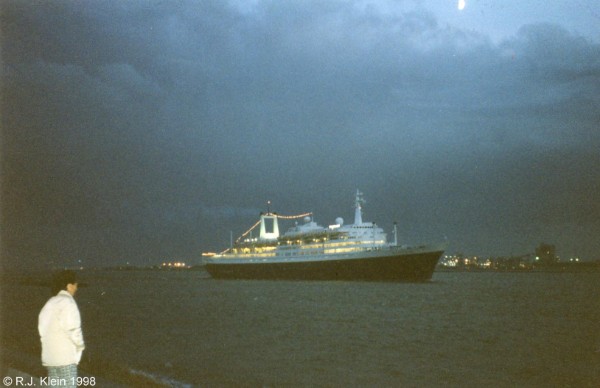
In 2000, Premier Cruises went bankrupt and all cruises were ended abruptly. Passengers had to embark in the next port of call and fly home themselves. Rembrandt embarked her passengers in Halifax, Canada. and was later laid up in Nassau on the Bahamas awaiting a buyer. Several scemes were put up, but the ship remained there untill she was bought by the Rotterdamse Droogdok Maatschappij, the company who build the ship. Owner of RDM, Joep van den Nieuwenhuyzen, set up a new company for the ship, the ss Rotterdam BV. This was financed by the Rotterdam harbour company with a pre-finance loan well over the buyingprice of 3,4 million euro, namely 48 million in total. But this money was not invested in the Rotterdam, though, but used for other parts within the companies that Van den Nieuwenhuyzen owned. Later, it became clear that the owner of the harbourcompany, Willem Scholten, secretly funded several companies from Van den Nieuwenhuyzen for the amount of 183,4 million euro without the backing of the citycouncil or his own board. Because of the problems this created, the RDM was declared bankrupt and the city of Rotterdam through the Rotterdam harbourcompany suddenly became the new owners of the ship, something they had rejected in 1997. The council of Rotterdam was not pleased, but took it up well and started finishing the contracts for the start of the eventual return of the ship to Rotterdam.
Below, Rotterdam is seen with an Oasis-class bird on her bow.
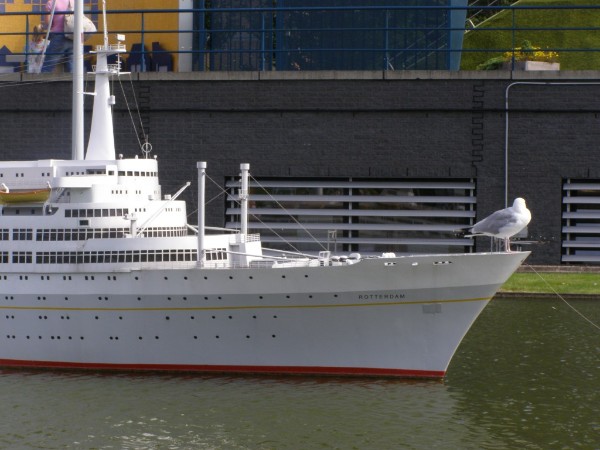
The thought that the ship would be scrapped was very real in this time. But in 2005, a year after the debacle of the RDM, the ship was bought by a consortium of Eurobalance and Woonbron, two Dutch companies. Woonbron is a Dutch housing company who estimated that rebuilding the ship would cost around 4 million euros and Eurobalance was the most important financer. They planned to bring the ship back to Rotterdam in 2007 and use her as a museum, learning center for the hotelschool and hotel/ restaurant. The ship was towed to Gibraltar and the rebuilding began. A lot of problems arose when the asbestos had to be removed from the ship and the costs rose higher than expected. The ship was again renamed Rotterdam and was towed to Gdansk for further reparations. Here again problems arose when the buyers discovered the bureaucracy they had to go through and there was nothing done to the ship at Gdansk. When the possibility arose, the ship was towed again to Wilhelmshaven in Germany and work started. At this time it was estimated that the whole conversion had cost around 200 million euros, somewhat more than Woonbron had announced. The whole company of Woonbron was worth almost this count and questions arose in Rotterdam if this was a good choise for a company that was supposed to create housing in some poor parts of the city of Rotterdam. Also, national politics started the debate and an inspector of the Secretary of Housing was sent down to Rotterdam to have an overview on the project. Although there were many complaints about the way everything was organised, the ship came finally back to Rotterdam in august 2008. First, the ship was to open for the public in november 2008 but that date was set forward to the end of july 2009. Finally, after some more delays, mostly because her interiour would not be ready on time, the ship opened at the 5th of february 2010.
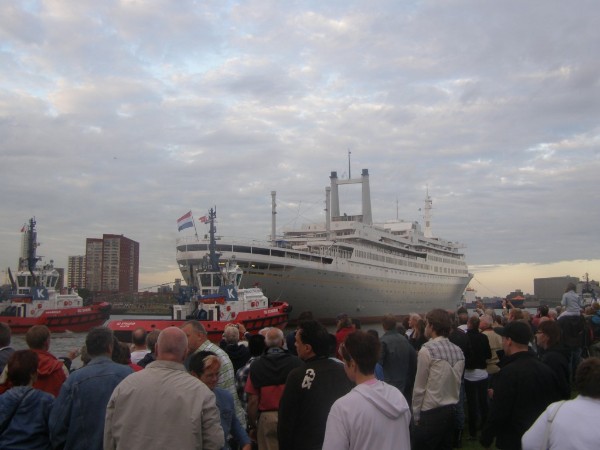
The picture above is showing Rotterdam on her current berthingplace, close to the old Holland America Line terminal, underneath is another picture of her arrival in Rotterdam and below that is how she looked in february 2010, some weeks before opening to the public, with also her lifeboats again in place.
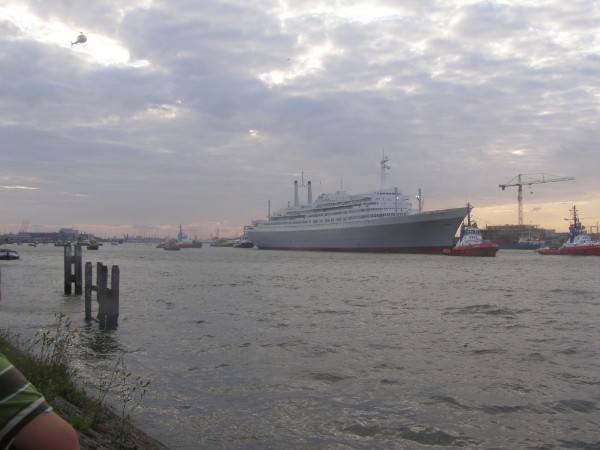
During 2012, because of the high costs that were made during the rebuilding of the ship for her current role, it was announced that the ship would be put up for sale again. The company Woonbron was forced by the Dutch secretary of Traffic and Waterways to sell the ship because of heir current financial position. There are talks going on with several parties, also one from Oman. When the ship would be sold to this company, it seemed likely that she was going to move to Oman to be used as a VIP-ship there and after all that was done, Rotterdam again would loose an icon from its past. Woonbron really wanted to see that the ship would stay in Rotterdam and luckily, in november of 2012 the ship was bought by WestCord Hotels for 29,9 million euro. Being a Dutch company, the future for the former Dutch flagship for Rotterdam was at least secured for the coming years.
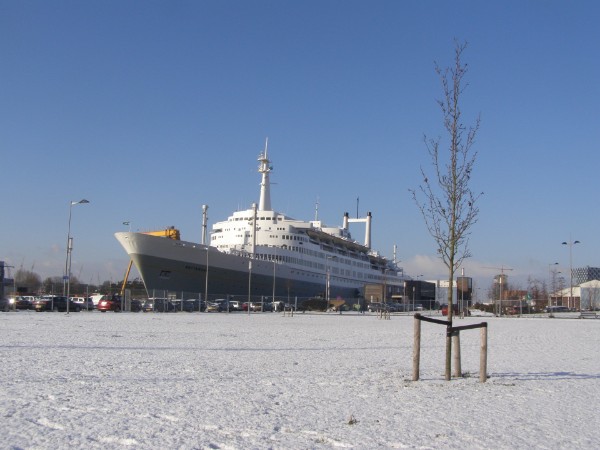
An important ship as this, has of course a great modelship too. In the miniature city of Madurodam, that is located in The Hague, a very large model of the ship is present, very close to a model of the former headoffice of the Holland America Line, nowadays the Hotel New York. At Madurodam, a lot of Dutch landmark buildings are brought together in miniature scale. A picture of the Madurodam model is shown below. While her normal sized sister was rebuilt, the model too was rebuilt by students of the Albeda College at Rotterdam, one of the schools that were going to use the ship for educational purposes. The ships model was carefully rebuilt to be an exact copy of the original, after the model had been repainted in an unsuitable way, representing a ship that wasn't a true replica. To add to the historic story, the ships Madurodam model was rebuilt and repainted at the former buildings sheds of the Rotterdam Drydock Company, the place where the ship was built at the end of the 1950's.
In the end of 2017, the ship was used as the background of the movie Love Cruise starring the Belgian/ Dutch entertainmentgroup K3. In the movie, the three K3 girls went on a cruise aboard the ship. Nice is that in the movie, the ship can again seen sailing due to visual effects. So she did get 'out of port' again some 10 years after she entered her final mooringsite.
